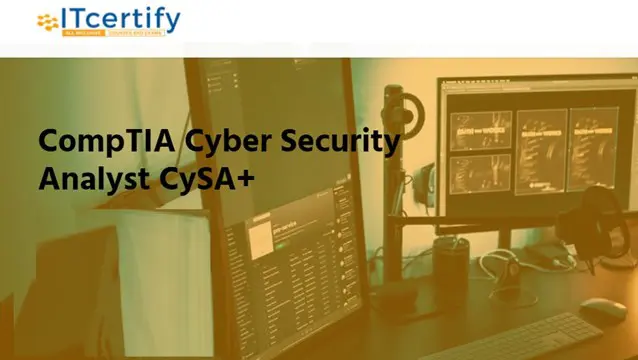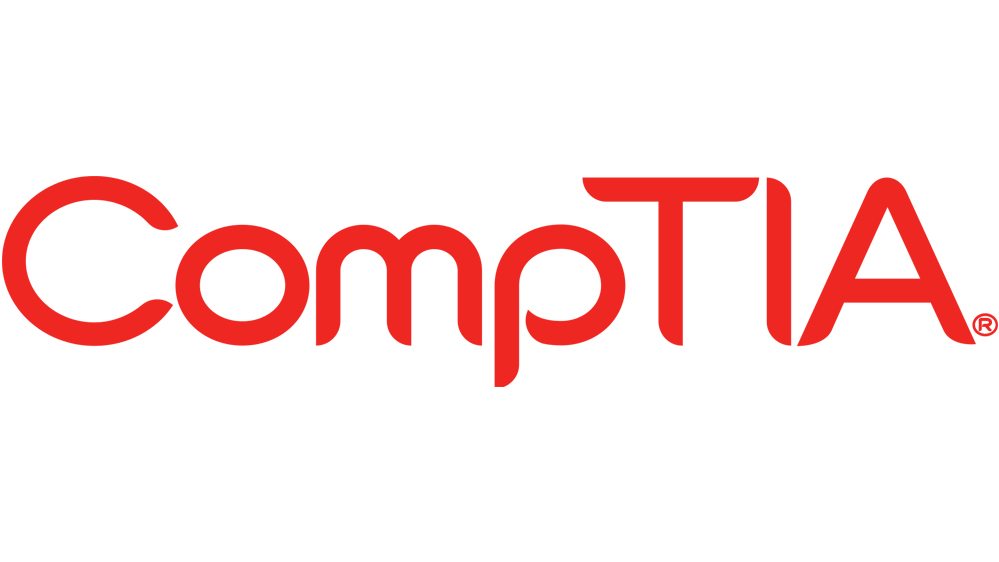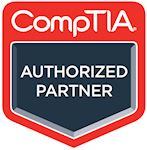
CompTIA Cyber Security Analyst CySA+
CompTIA Cyber Security Analyst Course - Engaging and expert online teachers - High pass rates - 12 months access
IT Certify
Summary
- Exam(s) / assessment(s) not included in price, and must be purchased separately
Add to basket or enquire
Overview
**Half Price Offer**
CompTIA Cyber Security Analyst CySA+
The CompTIA Cyber Security Analyst CySA+ focuses on the knowledge and skills required to configure and use threat-detection tools, perform data analysis, and interpreting the results with the end goal of securing an organization’s applications and systems.
The CompTIA Cyber Security Analyst CySA+ is a vendor neutral certification that expects three to four years of experience in a related field as well as a Security+ or equivalent knowledge.
The CompTIA Cyber Security Analyst CySA+ lies between the CompTIA Security + as well as the CompTIA Advanced Security Practitioner (CASP) exams and is an excellent go between to tackle before diving into the CASP, but when the Security+ isn’t enough.
Here you will gain an understanding of security best practices and protocols beyond that which is provided by the CompTIA Security + and will prove a level of expertise beyond that of basic security practices that are followed when using a computer. This allows any employee to prove a better understanding of enterprise security practices, and the necessary tools needed to protect a company network. The modules of this course align with the official objects of the certification and will expand past the scope of the certification to provide real life examples.
All delivered through our world class online portal:
Navigation and Controls
Our self paced training programmes allow you to study anywhere at any time. Pause, Rewind and play as many times as you like with 24 hour access.
Expert instructor led training
Our instructors are experts in the IT industry with a minimum of 15 years real world experience backed with many certifications in their subject of expertise
Visual demonstrations and multimedia presentations
Expert-led demonstrations and content rich presentations allow IT Certify students to develop their skills based on real world scenarios
Quizzes and exam simulators
Custom made practice exams reflect progress you have made throughout the course. Practice quizzes after each module build your confidence before moving to the next level.
Flash cards and educational games
IT Certify understand every student is unique and learns at a different pace. Our Flashcards and Educational Games are engineered to keep you engaged and 100% focused by providing a bit more fun to learning.
Exams are not included
Certification
CompTIA CySA+
Course media
Description
CompTIA Cyber Security Analyst + (CySA) Module Outline
Module 1. Threat Management
1.1 Introduction
1.2 Given a scenario, apply environmental reconnaissance
techniques using appropriate tools and processes Part 1
1.3 Given a scenario, apply environmental reconnaissance
techniques using appropriate tools and processes
1.4 Given a scenario, apply environmental reconnaissance
techniques using appropriate tools and processes
1.5 Given a scenario, apply environmental reconnaissance
techniques using appropriate tools and processes Part 4
1.6 Given a scenario, apply environmental reconnaissance
techniques using appropriate tools and processes Part 5
1.7 Given a scenario, apply environmental reconnaissance
techniques using appropriate tools and processes Part 6
1.8 Given a scenario, apply environmental reconnaissance
techniques using appropriate tools and processes Part 7
1.9 Given a scenario, apply environmental reconnaissance
techniques using appropriate tools and processes Part 8
1.10 Given a scenario, apply environmental reconnaissance
techniques using appropriate tools and processes Part 9
1.11 Given a scenario, analyze the results of a network
reconnaissance Part 1
1.12 Given a scenario, analyze the results of a network
reconnaissance Part 2
1.13 Given a scenario, analyze the results of a network
reconnaissance Part 3
1.14 Given a scenario, analyze the results of a network
reconnaissance Part 4
1.15 Given a scenario, analyze the results of a network
reconnaissance Part 5
1.16 Given a network-based threat, implement or recommend the appropriate response and countermeasure Part 1
1.17 Given a network-based threat, implement or recommend the appropriate response and countermeasure Part 2
1.18 Given a network-based threat, implement or recommend the appropriate response and countermeasure Part 3
1.19 Given a network-based threat, implement or recommend the appropriate response and countermeasure Part 4
1.20 Explain the purpose of practices used to secure a corporate environment Part 1
1.21 Explain the purpose of practices used to secure a corporate environment Part 2
1.22 Explain the purpose of practices used to secure a corporate environment Part 3
1.23 Explain the purpose of practices used to secure a corporate environment Part 4
Module 2. Vulnerability Management
2.1 Given a scenario, implement an information security
vulnerability management process Part 1
2.2 Given a scenario, implement an information security
vulnerability management process Part 2
2.3 Given a scenario, implement an information security
vulnerability management process Part 3
2.4 Given a scenario, implement an information security
vulnerability management process Part 4
2.5 Given a scenario, implement an information security
vulnerability management process Part 5
2.6 Given a scenario, implement an information security
vulnerability management process Part 6
2.7 Given a scenario, implement an information security
vulnerability management process Part 7
2.8 Given a scenario, analyze the output resulting from a
vulnerability scan Part 1
2.9 Given a scenario, analyze the output resulting from a
vulnerability scan Part 2
2.10 Compare and contrast common vulnerabilities found in
the following targets within an organization Part 1
2.11 Compare and contrast common vulnerabilities found in
the following targets within an organization Part 2
2.12 Compare and contrast common vulnerabilities found in
the following targets within an organization Part 3
Module 3. Cyber Incident Response
3.1 Given a scenario, distinguish threat data or behavior to
determine the impact of an incident Part 1
3.2 Given a scenario, distinguish threat data or behavior to
determine the impact of an incident Part 2
3.3 Given a scenario, distinguish threat data or behavior to
determine the impact of an incident Part 3
3.4 Given a scenario, prepare a toolkit and use appropriate
forensic tools during an investigation Part 1
3.5 Given a scenario, prepare a toolkit and use appropriate
forensic tools during an investigation Part 2
3.6 Given a scenario, prepare a toolkit and use appropriate
forensic tools during an investigation Part 3
3.7 Given a scenario, prepare a toolkit and use appropriate
forensic tools during an investigation Part 4
3.8 Given a scenario, prepare a toolkit and use appropriate
forensic tools during an investigation Part 5
3.9 Explain the importance of communications during the
incident response process
3.10 Given a scenario, analyze common symptoms to select
the best course of action to support incident response Part 1
3.11 Given a scenario, analyze common symptoms to select
the best course of action to support incident response Part 2
3.12 Given a scenario, analyze common symptoms to select
the best course of action to support incident response Part 3
3.13 Given a scenario, analyze common symptoms to select
the best course of action to support incident response
Module 4. Security Architecture and Tool Sets
4.1 Explain the relationship between frameworks, common
policies, controls, and procedures Part 1
4.2 Explain the relationship between frameworks, common
policies, controls, and procedures Part 2
4.3 Explain the relationship between frameworks, common
policies, controls, and procedures Part 3
4.4 Explain the relationship between frameworks, common
policies, controls, and procedures Part 4
4.5 Given a scenario, use data to recommend remediation of
security issues related to identity and access management
Part 1
4.6 Given a scenario, use data to recommend remediation of
security issues related to identity and access management
Part 2
4.7 Given a scenario, use data to recommend remediation of
security issues related to identity and access management
Part 3
4.8 Given a scenario, use data to recommend remediation of
security issues related to identity and access management
Part 4
4.9 Given a scenario, review security architecture and make
recommendations to implement compensating controls Part 1
4.10 Given a scenario, review security architecture and make
recommendations to implement compensating controls Part 2
4.11 Given a scenario, review security architecture and make
recommendations to implement compensating controls Part 3
4.12 Given a scenario, use applications security best practices
while participating in the Software Development Life Cycle
(SDLC) Part 1
4.13 Given a scenario, use applications security best practices
while participating in the Software Development Life Cycle
(SDLC) Part 2
4.14 Overview
4.15 Conclusion
Who is this course for?
Anyone with an interest in a career in IT
Requirements
No age limits and no experience needed
Career path
Just some of the jobs you can move into when you pass with IT Certify:
1st and 2nd Line Support Technician
Computer Support Specialist
IT Technician
IT Support Engineer
IT Support Analyst
Network Administrator
Network Technician
Network Support Engineer
Desktop Support Technician
Service Desk Administrator
Computer Support Administrator
IT Support Technician
Helpdesk Manager
Senior IT Technician
Questions and answers
Reviews
Currently there are no reviews for this course. Be the first to leave a review.
Legal information
This course is advertised on reed.co.uk by the Course Provider, whose terms and conditions apply. Purchases are made directly from the Course Provider, and as such, content and materials are supplied by the Course Provider directly. Reed is acting as agent and not reseller in relation to this course. Reed's only responsibility is to facilitate your payment for the course. It is your responsibility to review and agree to the Course Provider's terms and conditions and satisfy yourself as to the suitability of the course you intend to purchase. Reed will not have any responsibility for the content of the course and/or associated materials.






